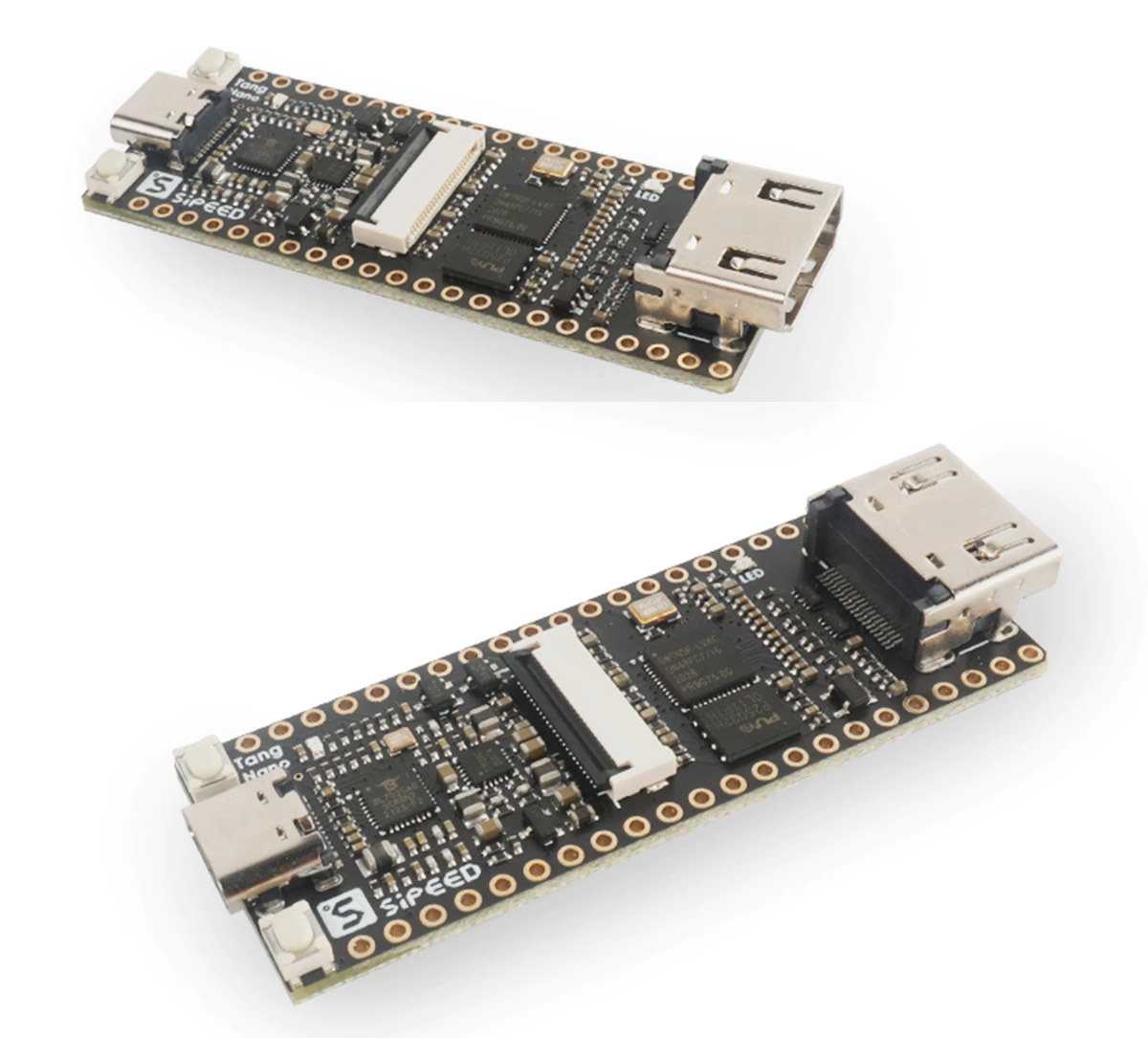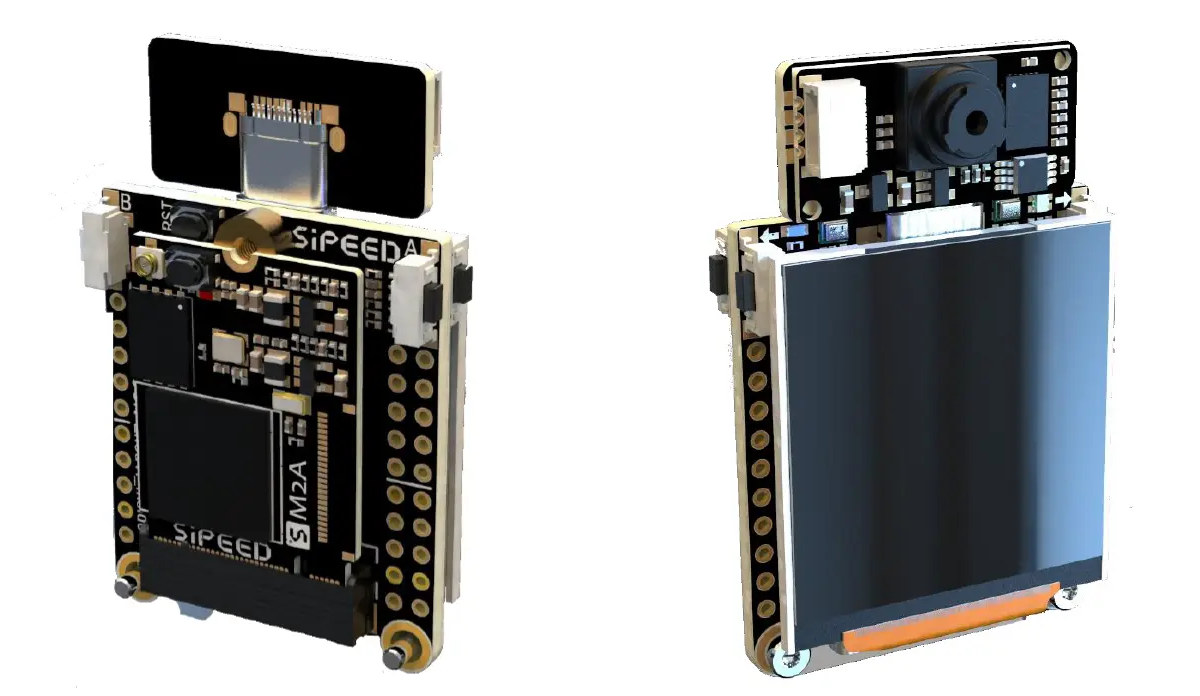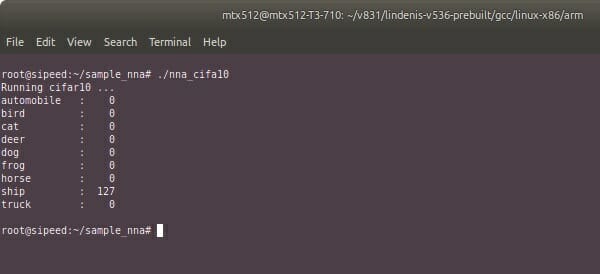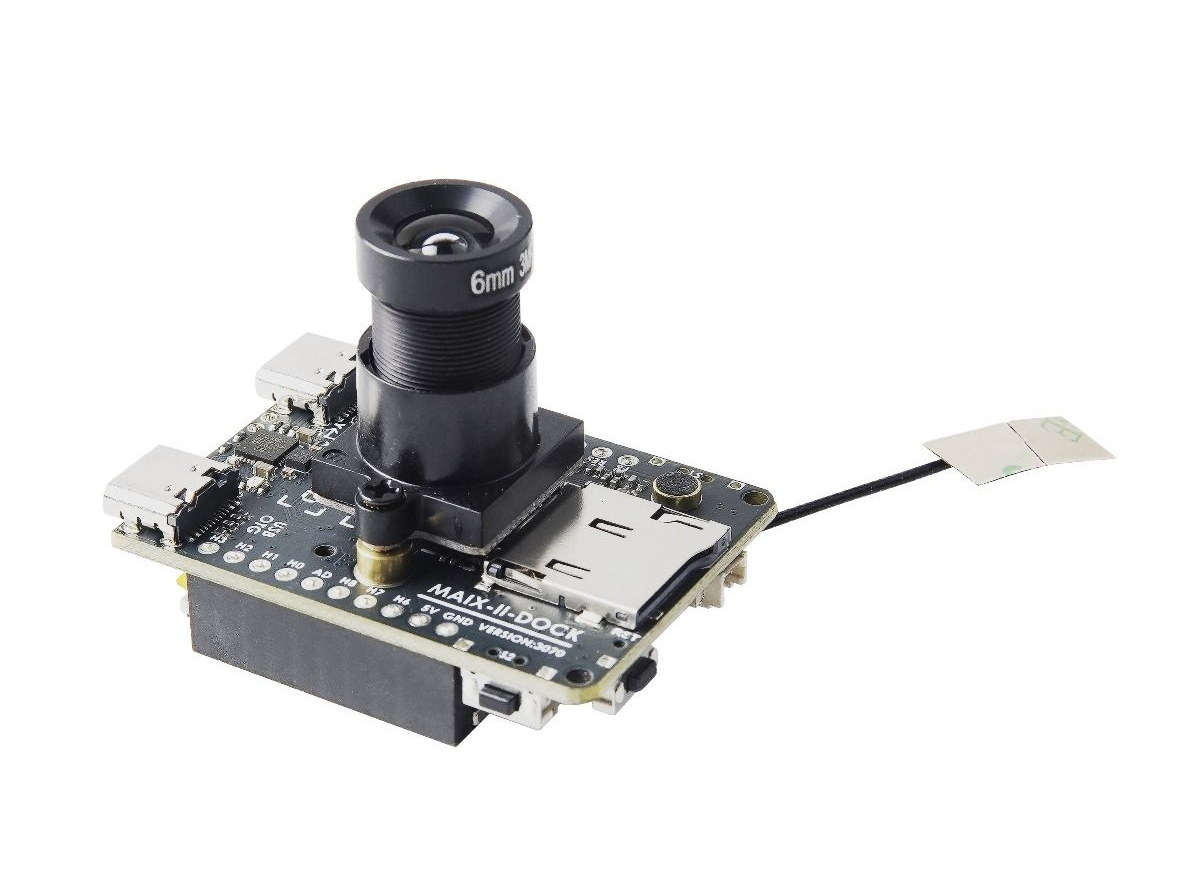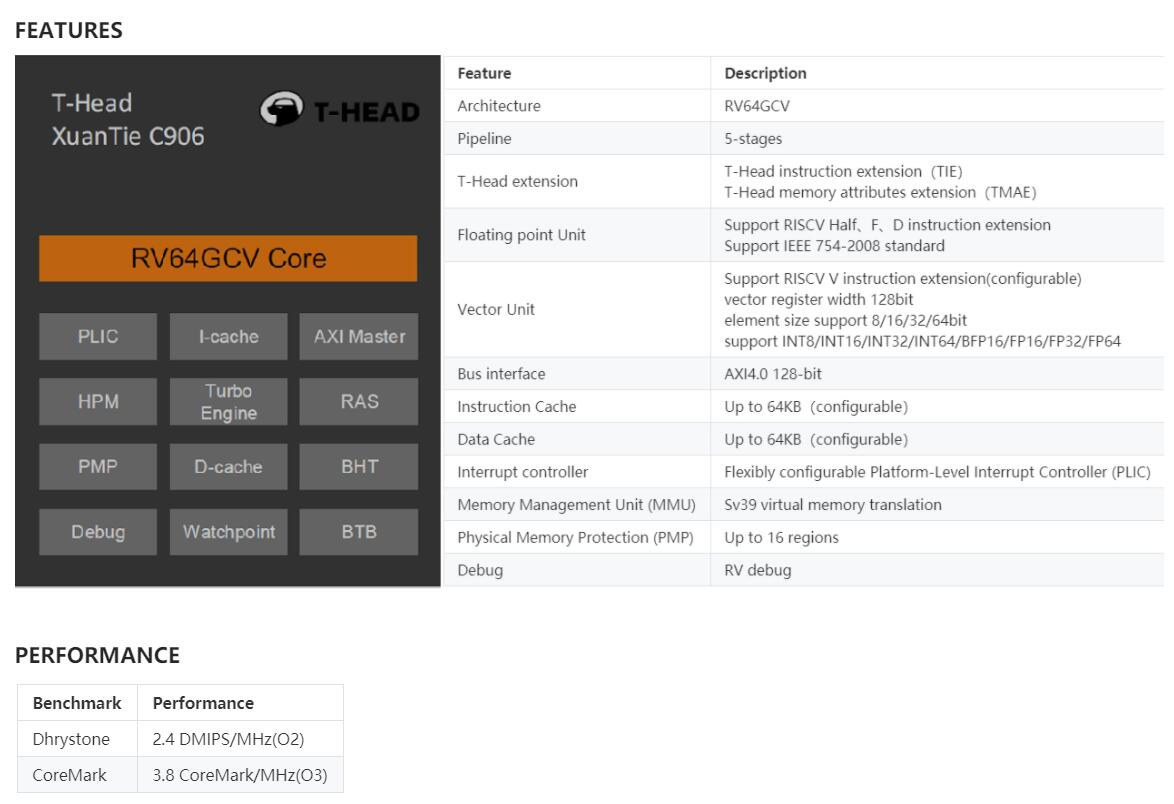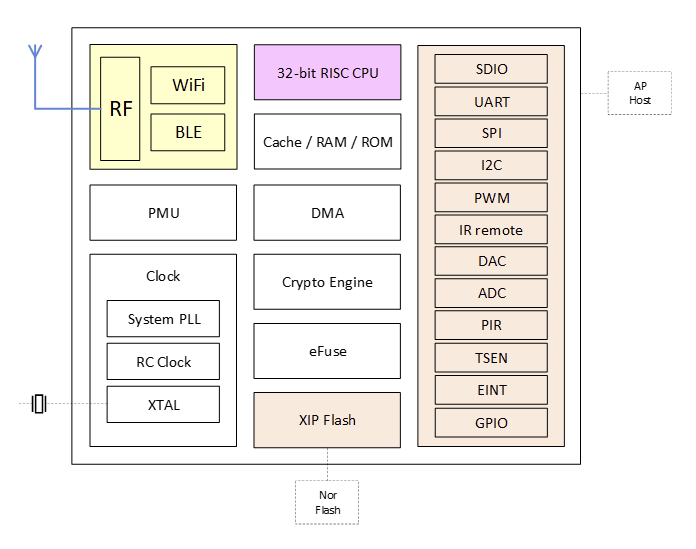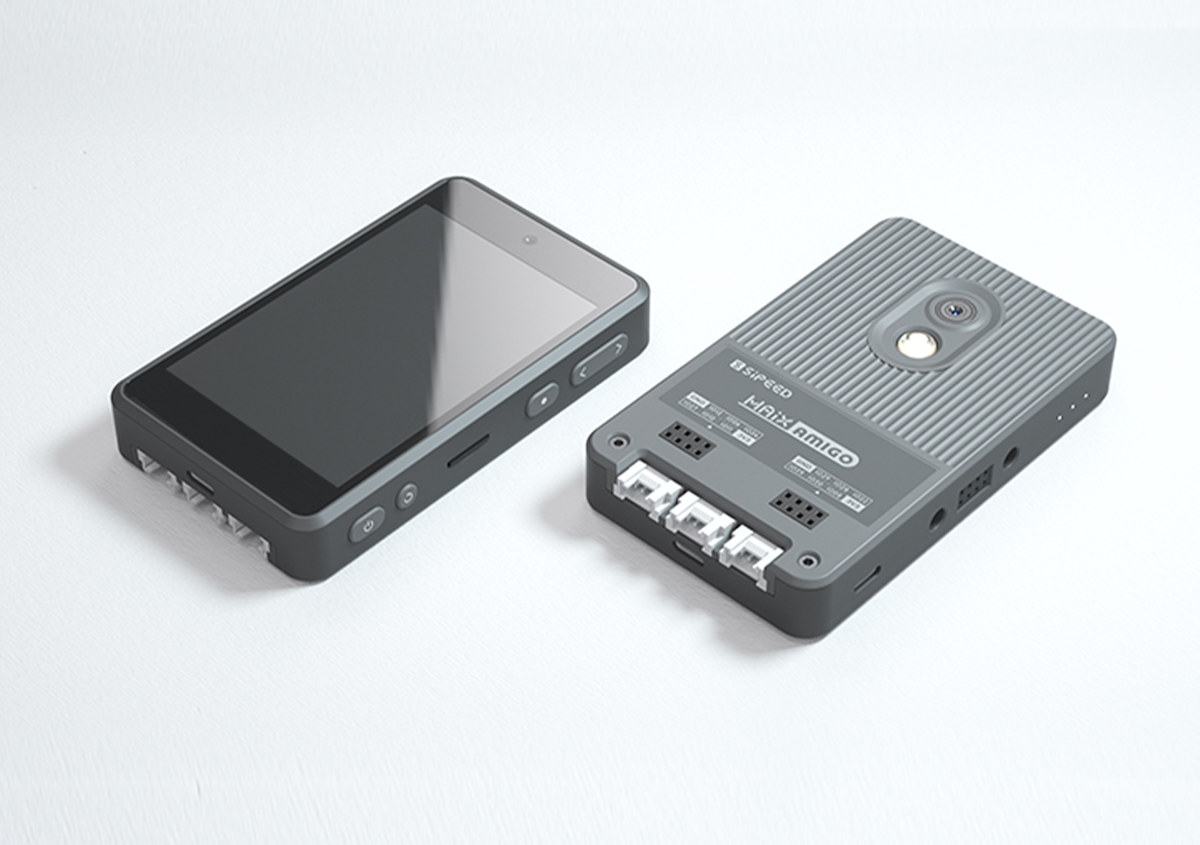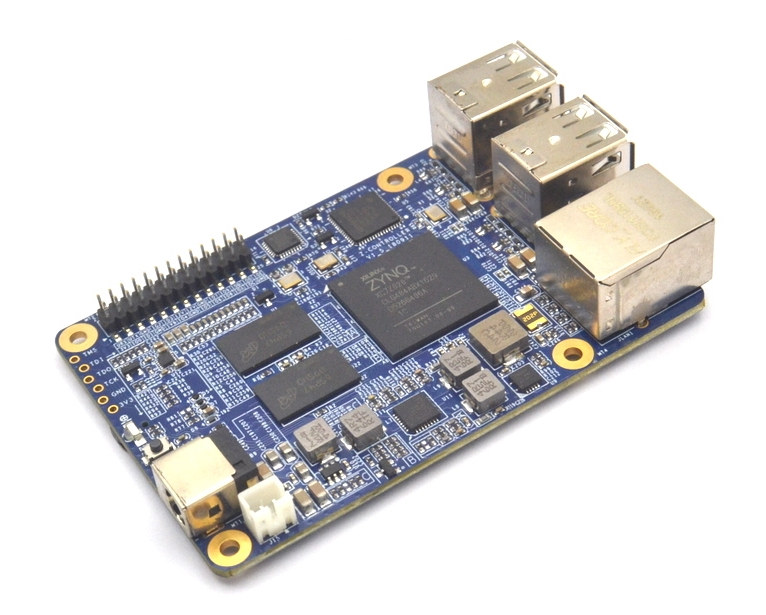Sipeed’s Tang Nano 4K FPGA board is an upgrade to the company’s Tang Nano FPGA board with a more powerful GOWIN GW1NSR-LV4C FPGA with 4608 LUT (instead of 1152) and a Cortex-M3 microcontroller embedded into the chip. Like the previous board, the new Tang Nano 4K features a USB-C port for power and downloading the bitstream, but replace the RGB LCD interface with an HDMI port, and adds support for an optional OV2640 camera. Tang Nano 4K board specifications: FPGA – GOWIN GW1NSR-LV4C aka GW1NSR-4C (See PDF datasheet for details) with 4608 logical units (LUTs) 3456 registers 16 multiplier parameters 180Kbit block SRAM, 64Mbit PSRAM 2x PLL Up to 44x user I/O Arm Cortex-M3 hard processor Storage – 32 Mbit NOR flash Video Output – HDMI port Camera I/F – DVP camera connector for OV2640 camera sensor up to 1600 x 1200 (UXGA) resolution USB – USB Type-C port for […]
MAIX-II A AI camera board combines Allwinner R329 smart audio processor with USB-C camera
Earlier this year, we wrote about Sipeed MAIX-II Dock AIoT vision devkit with an Allwinner V831 camera processor with a small 200 MOPS NPU, an Omnivision SP2305 2MP camera sensor, and a 1.3-inch display. But for some reason, which could be supply issues, Sipeed has designed a much different variant called MAIX-II A with a board based on Allwinner R329 smart audio processor, a 720p30 USB camera module, and a 1.5-inch display. MAIX-II A board specifications: Main M.2 module – Maix-II A module with Allwinner R329 dual-core Cortex-A53 processor @ 1.5 GHz, 256MB DDR3 on-chip, a dual-core HIFI4 DSP @ 400 MHz, and Arm China AIPU AI accelerator for up to 256 MOPS, plus Wi-Fi & BLE and a footprint for an SPI Flash. Storage – MicroSD card socket Display – 1.5-inch LCD display with 240×240 resolution Audio – Dual microphones, 3W speakers Camera – 720p USB-C camera module based […]
Allwinner V831 NPU (Neural Processor Unit) reverse-engineered
When Sipeed introduced MAIX-II Dock AIoT vision development kit, they asked help from the community to help reverse-engineer Allwinner V831‘s NPU in order to make an open-source AI toolchain based on NCNN. Sipeed already had decoded the NPU registers, and Jasbir offered help for the next step and received a free sample board to try it out. Good progress has been made and it’s now possible to detect objects like a boat using cifar10 object recognition sample. Allwinner V831’s NPU is based on a customized implementation of NVIDIA Deep Learning Accelerator (NVDLA) open-source architecture, something that Allwinner (through Sipeed) asked us to remove from the initial announcement, and after reverse-engineering work, Jasbir determined the following key finding: The NPU clock defaults to 400 MHz, but can be set between 100 and 1200 MHz NPU is implemented with nv_small configuration (NV Small Model), and relies on shared system memory for all […]
Sipeed MAIX-II Dock is an Allwinner V831 powered AIoT vision devkit
Sipeed introduced MAIX development boards powered by Kendryte K210 dual-core RISCV processor with AI accelerators in 2018, and we tested the Maixduino and Grove AI HAT based on the solution using Arduino and Micropython the following year. It works fine for audio and video project requiring AI acceleration at low power, but performance (resolution/fps) is limited. So if you’d like a bit more oomph for your audio & vision AI projects, as well as proper Linux support, Sipeed has just launched MAIX-II Dock powered by Allwinner V831 Cortex-A7 AI camera SoC clocked at up to 800-1000 MHz and 64MB on-chip DDR2 RAM, as well as a Full HD camera and a small display.MAIX-II Dock specifications: MAIX-II core module SoC – Allwinner V831 single-core Cortex-A7 processor clocked at 800-1000 MHz with 0.2TOPS AI accelerator, H.264/H.265/JPEG video encoder up to 1080p30 System Memory – 64MB DDR2 in package (SiP) Storage – Optional […]
XuanTie C906 based Allwinner RISC-V processor to power $12+ Linux SBC’s
Alibaba unveiled Xuantie-910 RISC-V core (aka XT910) in 2019 for powerful SoC with up to 16 cores, but an update in 2020 revealed the company planned to have a complete RISC-V core family for a wide range of application from low-power microcontrollers to server SoCs. At the time, I just assumed the company planned to keep their cores to themselves, but time proved me wrong as T-Head, the Alibaba subsidiary in charge of developing RISC-V cores, started to cooperate with Allwinner to develop open-source processors, which should lead to low-cost Linux capable RISC-V SBC very soon according to a tweet from Sipeed. Good News: We get first chip which based on XuanTie C906 (RV64GCV), it have abundant interface (HDMI/RGB/DVP/MIPI/GMAC/…), and will be able to run Debian system.Last and most important, the basic dev board price is start at 12.5$ (1% of HiFive Unleashed)。 pic.twitter.com/EJbXTJ5eMb — Sipeed (@SipeedIO) November 6, 2020 […]
BL602/BL604 RISC-V WiFi & Bluetooth 5.0 LE SoC will sell at ESP8266 price point
Hisilicon Hi3861 may be the first RISC-V WIFI SoC we’ve reported on, but due to political uncertainties and security concerns, supplies may not be available outside of China. So alternatives are welcomed, and Nanjing-based Bouffalo Lab (not a typo, 博流智能科技 in Chinese) has recently introduced BL602 and BL604 32-bit RISC-V WiFi and Bluetooth LE SoC for low-power IoT applications that are supposed to compete against ESP8266 in terms of price but with higher performance and additional features. The BL602 will also be integrated into an upcoming Sipeed Longan-series board, and potentially a new IoT board from Pine64. BL602 / BL604 key features & specifications: MCU subsystem – 32-bit RISC-V CPU with FPU with dynamic frequency from 1MHz to 192MHz, L1 cache Memory – 276KB SRAM on-chip Storage 128KB ROM, 1Kb eFuse, and optional Embedded Flash on-chip XIP QSPI flash support Wireless Wi-Fi 4 – 802.11 b/g/n @ 2.4 GHz Bluetooth […]
Sipeed Maix Amigo is a Portable 64-bit RISC-V AI Development Kit with Display and Cameras
Earlier this year, Seeed Studio introduced Wio Terminal a portable Arduino devkit with an LCD display, and expansion connectors and headers. The company is now selling a similar looking devkit but for different applications with Sipeed Maix Amigo portable 64-bit RISC-V development kit powered by Kendryte K210 RISC-V AI processor and equipped with an LCD display, two cameras, a few buttons, and several I/O headers and Grove connectors. Sipeed Maix Amigo specifications: SoC – Kendryte K210 Dual-core 64-bit RISC-V (RV64GC) processor with FPU @ 400 MHz (overclockable to 500MHz), 8MB SRAM, built-in AI accelerators for video and audio Storage – 16MB Flash, MicroSD card slot up Display – 3.5-inch TFT capacitive touch screen display with 480×320 resolution Camera VGA front-facing camera up to 30 fps (GC0328 sensor) VGA rear camera up to 60 fps (OV7740 sensor) Audio – Build-in microphone, optional 6-mic array USB – 1x USB Type-C port for […]
Sipeed TANG Hex is a Low-Cost Xilinx Zynq-7020 Arm FPGA Board
Last year, Sipeed launched a $5 FPGA board called Sipeed Tang and based on an entry-level Gowin GW1N-1-LV FPGA. But I had not noticed the company had also worked on a more powerful, yet still low-cost Xilinx Zynq-7020 board in a business card form factor not too dissimilar from the Raspberry Pi model B form factor. Meet Sipeed TANG Hex. So far a low-cost Zynq-7010 or Zynq-7020 board met you had to spend $99 to $199 with products such as MyIR Z-Turn and Digilent PYNQ-Z1. But Sipeed Tang HEX can be purchased for as little as $73 shipping on Aliexpress, or 439 RMB ($62) on Taobao for people based in mainland China. It might be tempting to get a low-cost board to get started, but is it worth it? Read on to find out. Sipeed TANG Hex specifications: SoC – Xilinx Zynq-7020 (XC7Z020-1CLG484) dual-core Arm Cortex-A9 processor and FPGA with […]


